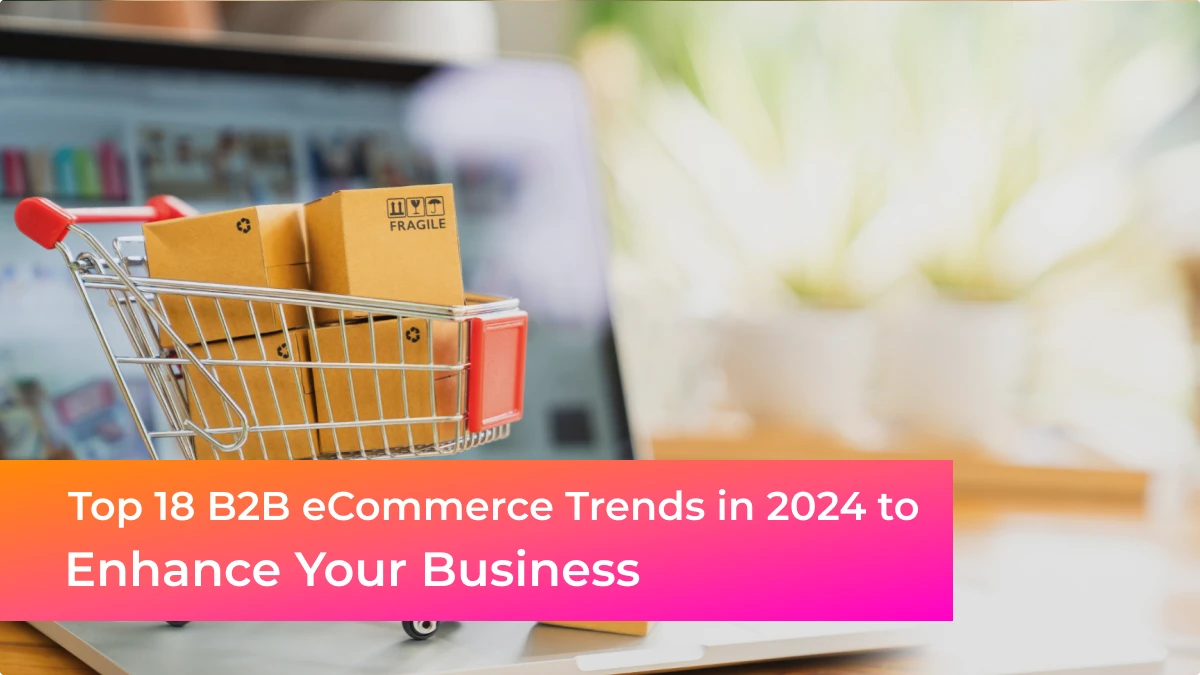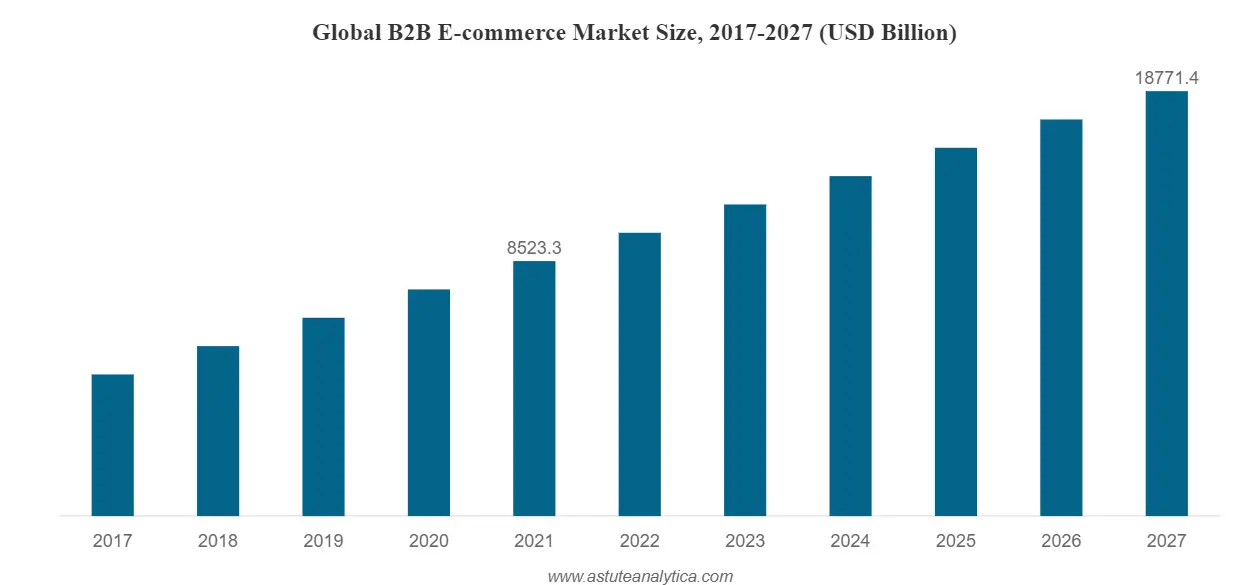
PRAVIN KAMBLE

As the world of eCommerce continues to evolve, it is becoming increasingly important for companies to stay updated with the b2b ecommerce trends. The fast growth has led to a rise in competition among eCommerce firms, and they are investing in tools and resources to stand out from the crowd. Otherwise, it is easy to be swept away in a sea of eCommerce stores.
Online retail sales are estimated to exceed $6.93 trillion this year, and eCommerce stores might take up 22.3% of it.
If you run a B2B business, it’s the right time for you to look at the latest trends in eCommerce to stay ahead of the curve. To start with, providing high-quality products, setting up a seamless customer journey, and focusing on personalization, are a few points you can consider going for.
However the list is long, and in this blog we have listed the most hot b2b eCommerce trends in 2024.
In the following sections, we will explore stats related to B2B eCommerce and the top trends in b2b ecommerce. These trends are expected to shape the business landscape this year.
Table of Contents:
B2B eCommerce kept growing in 2024 as more companies depended on digital channels for their acquisition requirements. According to Astute Analytica, the global B2B eCommerce market size will reach $18,771.4 billion by 2027, primarily due to the increased focus on digital experiences and the rising popularity of specialized online marketplaces that act as intermediaries between B2B sellers and buyers. This shift toward digitalization allows businesses to broaden their reach and serve a wider audience beyond their physical limits.

Additionally, a survey published by Forrester Research showed that in the US alone, B2B eCommerce transactions will touch $3 trillion by 2027, showing the market’s strength and potential to grow. The use of B2B eCommerce systems is anticipated to increase across several industries, including manufacturing, wholesale commerce, and services, as companies embrace digital transformation.
A recent study by Gartner conducted towards the end of 2021 revealed that 83% of B2B buyers prefer to use digital channels to place orders and make payments. This preference is because online shopping is more convenient, faster, and offers a broader range of options. Furthermore, the COVID-19 epidemic has increased the use of digital commerce in the B2B sector, supporting this choice.
B2B ecommerce businesses must now focus beyond having an essential website or an average customer experience. Unfortunately, 45% of B2B buyers think that online buying is more complicated than offline. To make matters worse, an alarming 90% of B2B buyers would opt for a competitor’s service if a supplier’s digital channel failed to meet their needs.
Therefore, B2B companies need to prioritize their digital transformation efforts in 2024 to provide their customers with the eCommerce experiences they expect.
Here are the top 18 B2B eCommerce trends to watch for in 2024:
With a dime-a-dozen eCommerce stores present, you got to offer nothing but the best to keep your customers hooked. Even the simplest of things create a tectonic shift in your brand in the minds of your customers.
For example, offering extra convenience or free shipping to increase their chances of buying from you.
The opportunity for customers to communicate with your business through multiple channels is one of the best aspects of customer service. It is no longer a luxury since every customer expects it these days. As of now, around 52% of eCommerce retailers have omnichannel capabilities. It is one of the simplest methods for retaining customers.
You will be able to provide an excellent shopping experience to your customers using omnichannel communication by understanding them deeply. It would help if you researched the channels they use and how they use them and have a clear idea about the buyer’s journey.
By ensuring that your website or app is mobile-friendly, you can provide your B2B buyers with seamless and easy browsing and purchasing experiences, across any device they use. This not only enhances user satisfaction but also increases the likelihood of conversion, and repeat users - ultimately driving growth for your business in the competitive B2B eCommerce industry.
Automation is becoming more common in the realm of eCommerce, transforming how firms run and interact with their customers. It is the use of technology to execute tasks that would otherwise necessitate manual labour. Automation has shown to be a game-changer in the field of b2becommerce.
Companies can increase sales productivity by 14.5% and save marketing costs by 12.2% by automating certain company activities. In order to maintain a competitive edge and attain long-term expansion in the contemporary digital marketplace, organizations must proficiently exploit automation technologies. It follows that automation must be adopted as a strategic necessity.
.webp)
It provides an opportunity for the customers to check out the various options available without having to get on a call with a sales representative. Businesses can start with simple self-service options such as tracking orders or accepting payments.
eCommerce store owners should prioritize improving current relationships while also encouraging consumer loyalty and retention. Achieving this goal may be made easier by implementing strategies like loyalty programs and gift cards into practice.
According to a report by Statista, social commerce sales worldwide are projected to exceed $2.2 trillion by 2025, highlighting the significant growth and potential of this trend. With platforms like LinkedIn, Facebook, and Instagram providing advanced features such as shoppable posts, B2B companies can interact more easily and consistently with their audience, boosting sales and building brand loyalty.
B2B companies can enhance sales and online presence by implementing social commerce into their ecommerce strategy. Social media networks provide a wide range of users and engagement opportunities.
.png)
According to Statista, B2B marketplaces are expected to constitute 17% of worldwide B2B sales by 2023, indicating strong growth prospects for enterprises. Additionally, a report by Forrester projects that B2B marketplaces will generate $3.6 trillion in sales globally in 2024.
This highlights the significant growth potential of B2B marketplaces and emphasizes the importance for businesses to broaden their presence on these platforms. Integrating with third-party B2B marketplaces not only provides convenience for buyers but also allows businesses to access a larger audience and profit on the growing trend of digital transactions.
They can check the product during pickup and return it if they think it is damaged or not what they expected. The chances of the product getting stolen after delivery become nil.
This may involve moving from traditional on-premise solutions to cloud-based platforms for enhanced scalability and flexibility. Similarly, outdated legacy systems for customer relationship management (CRM) and enterprise resource planning (ERP) can be replaced with integrated solutions to streamline operations and improve efficiency.
For example, utilizing rewards programs, store credit, and coupons can facilitate smoother transitions by providing advanced features tailored to enhance customer engagement and retention. By migrating to a dedicated eCommerce platform with integrated CRM and ERP functionalities, businesses can ensure a consistent consumer experience while remaining competitive in the market.

Automation is a critical process in achieving this goal, as it enables businesses to use artificial intelligence and complex algorithms to streamline order processing, inventory management, and shipping.
Moreover, firms can integrate real-time data analytics to estimate demand more accurately, which reduces the risk of stockouts and minimizes order fulfillment delays. Improvements in supply chain management, such as the use of blockchain technology, can also enable increased efficiency and transparency throughout the fulfillment process.
In the end, prioritizing quicker order fulfillment boosts client happiness and gives companies a competitive advantage in the ever-changing world of B2B ecommerce.
In the ecommerce sector, tailored interactions are improving online consumer experiences by taking into account factors such as location, browsing history, and past purchases. According to CMSwire, hyper-personalization has been shown to improve business results for 86% of businesses. In the B2B sphere, personalization is essential to keep up with B2C standards.
Understanding your users well is the first step towards optimizing your strategy. You can even divide your audience into segments for focused experiences, and suggest products that fit each segment. These actions will help you maintain connected and engaged clients.
Providing several payment alternatives helps purchasers to select ways that are needed for their cash flow, budgeting, and financial preferences.This way, buyers can select the payment method that’s most convenient for them, reducing hassle in the transaction and potentially speeding up the buying process.
In order to handle different B2B transactions, we anticipate more B2B organizations to explore commerce solutions that allow several payment methods, such as invoicing, purchase orders, credit lines, and online payments.
Once it’s up and running, headless makes it easier to lower your website budget, as you won’t need technical support to update the back end every time you want to make a slight adjustment to the front end.
Thanks to machine learning algorithms, these systems continuously adjust to changing market conditions. As a result, companies can optimize their inventory, reduce cost, and enhance the efficiency of their operations.
.png)
These programs contribute to stronger brand loyalty, increased revenue, and easier customer acquisition by providing incentives and rewards for repeat purchases, encouraging emotional connections with the brand, increasing customer engagement, and leveraging data-driven insights to tailor personalized experiences, thereby improving overall customer satisfaction and loyalty.
On average, each American consumers holds 16.7 customer loyalty programs. It’s important to design your loyalty program in a way that attracts and retains your customers. Some of the most popular loyalty programs are points, tiered loyalty, paid, and universal loyalty programs. The right rewards for your customers depend on what they’re looking for. To determine this, focus on data and analysis, and use loyalty program software.
.webp)
It provides predictable and recurring revenue, grants access to valuable customer data, and increases the average order value and customer lifetime value. Even customers love the subscription model since it provides a balance between price and value.
.webp)
AI is transforming eCommerce by improving user experiences with real-time chatbot support and tailored recommendations. Furthermore, AI-driven analytics enable companies to forecast customer behavior and enhance inventory control, making them an essential part of B2B eCommerce trends. Virtual reality (VR) and machine learning (ML) are two other technologies that are influencing B2B eCommerce in addition to artificial intelligence (AI).
Businesses can position themselves for significant revenue growth by staying up-to-date with the latest b2b eCommerce trends and making necessary adjustments to fit the market realities. By harnessing automation, omnichannel sales, expansion into third-party B2B marketplaces, giving importance to mobile optimization, maintaining customer service standards, and building enduring relationships with customers, businesses may put themselves at the top of the digital transformation.
Finding methods to draw in new clients is vital, but it’s just as critical to develop strategies that keep existing ones coming back. For eCommerce businesses looking to grow with a powerful loyalty reward program, we are here to help.